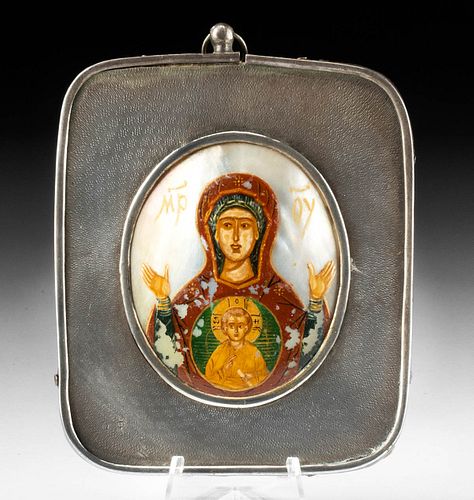19th C. Russian Painted Nacre Icon Silver Frame
Lot 175d
About Seller
Artemis Fine Arts
686 S Taylor Ave, Ste 106
Louisville, CO 80027
United States
Selling antiquities, ancient and ethnographic art online since 1993, Artemis Gallery specializes in Classical Antiquities (Egyptian, Greek, Roman, Near Eastern), Asian, Pre-Columbian, African / Tribal / Oceanographic art. Our extensive inventory includes pottery, stone, metal, wood, glass and textil...Read more
Estimate:
$1,400 - $2,100
Absentee vs Live bid
Two ways to bid:
- Leave a max absentee bid and the platform will bid on your behalf up to your maximum bid during the live auction.
- Bid live during the auction and your bids will be submitted real-time to the auctioneer.
Bid Increments
| Price | Bid Increment |
|---|---|
| $0 | $25 |
| $300 | $50 |
| $1,000 | $100 |
| $2,000 | $250 |
| $5,000 | $500 |
| $10,000 | $1,000 |
| $20,000 | $2,500 |
| $50,000 | $5,000 |
| $100,000 | $10,000 |
| $200,000 | $20,000 |
About Auction
By Artemis Fine Arts
Jan 21, 2021
Set Reminder
2021-01-21 10:00:00
2021-01-21 10:00:00
America/New_York
Bidsquare
Bidsquare : Ancient / Ethnographic From Around The World
https://www.bidsquare.com/auctions/artemis-gallery/ancient-ethnographic-from-around-the-world-6316
Ancient art from Egypt, Greece, Italy and the Near East, as well as Asian, Pre-Columbian, Native American, African / Tribal / Oceanic, Spanish Colonial, Russian Icons, Fine art, much more! All categories, all price ranges... all legally acquired and guaranteed to be as described or your money back. Artemis Fine Arts info@artemisgallery.com
Ancient art from Egypt, Greece, Italy and the Near East, as well as Asian, Pre-Columbian, Native American, African / Tribal / Oceanic, Spanish Colonial, Russian Icons, Fine art, much more! All categories, all price ranges... all legally acquired and guaranteed to be as described or your money back. Artemis Fine Arts info@artemisgallery.com
- Lot Description
Eastern Europe, Russia, ca. 19th century CE. A petite icon of the Virgin Orans (also Orant from the verb orare meaning to pray) hand-painted in jewel tone hues and gold leaf on an oval piece of beautiful, iridescent white nacre (mother of pearl) and set in a silver frame with a suspension loop at the upper end. The Virgin and Child are presented with Mary making a dramatic prayerful gesture, her arms raised and the palms of her hands turned upward toward the heavenly realm. This pose was, according to scholar Alfredo Tradigo, "the simplest means by which early Christian art represented the soul of the deceased (often a martyr) awaiting eternal life in Christ." Her pose recalls that of Christ on the Cross and was intended to show her sending prayers outward. Lucite stand for photographic purposes only. Size: 4.3" L x 3.5" W (10.9 cm x 8.9 cm)
An image of Christ Emmanuel is over her heart in a manner similar to that of Byzantine court members who wore medallions depicting their emperor. From this idea came the iconography of the Virgin of the Sign as derived from the prophesy of Isaiah (7:14). The image of Emmanuel represents the image of the Eucharist - he who sacrifices and is being sacrificed.
Icons (icon means "image" in Greek) are sacred objects within the Eastern Orthodox Christian tradition. Found in homes as well as churches, these painted images depict holy persons and saints as well as illustrate scenes from the Scriptures. Icons are not worshiped, but are instead venerated for their ability to focus the power of an individual's prayer to God. As such they are truly "windows into heaven."
Provenance: ex-Estate of Dr. W.M. Bogdanowicz, Naples, Florida USA
All items legal to buy/sell under U.S. Statute covering cultural patrimony Code 2600, CHAPTER 14, and are guaranteed to be as described or your money back.
A Certificate of Authenticity will accompany all winning bids.
We ship worldwide and handle all shipping in-house for your convenience.
#160751Crack to center of upper end of frame with a bit of separation at the border in that vicinity and some loss. Some areas of loss to paint as shown, but depiction is still vivid. Silver has developed a warm age patina.Condition
- Shipping Info
-
All shipping is handled in-house for your convenience. Your invoice from Artemis Gallery will include shipping calculation instructions. If in doubt, please inquire BEFORE bidding for estimated shipping costs for individual items.
-
- Buyer's Premium



 EUR
EUR CAD
CAD AUD
AUD GBP
GBP MXN
MXN HKD
HKD CNY
CNY MYR
MYR SEK
SEK SGD
SGD CHF
CHF THB
THB















